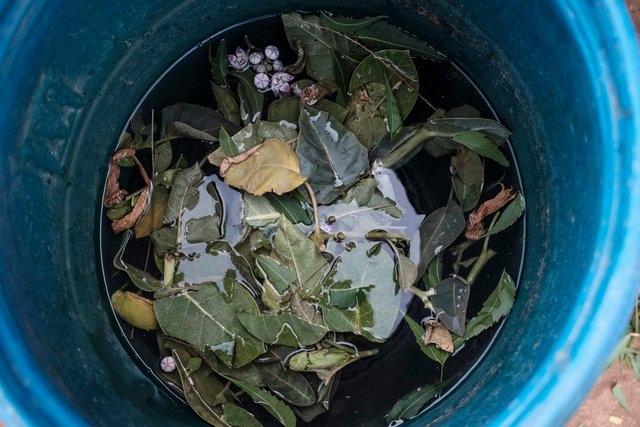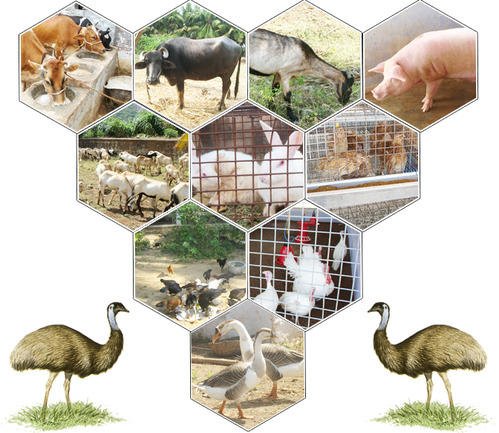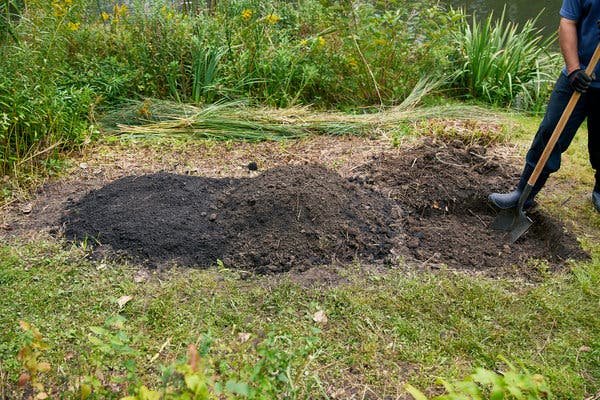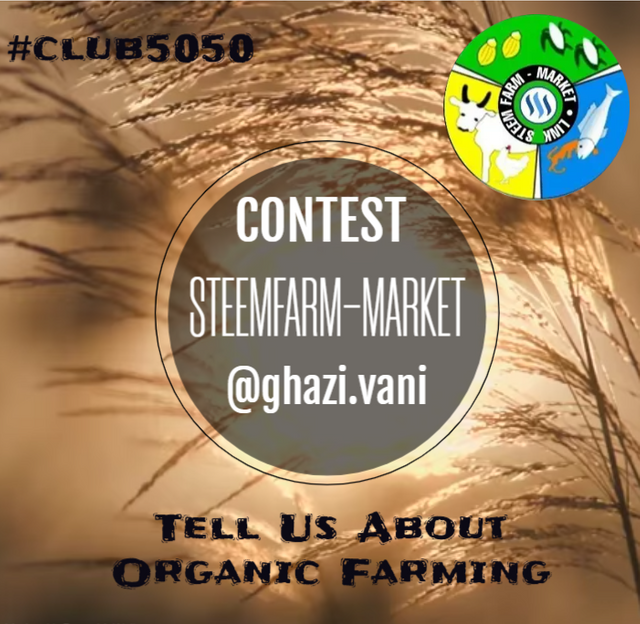Hello Everyone!
It's "Umair Zahid" I hope you all are happy and fine with your family. I’m so happy to participate in this contest, Today I will tell you about Organic Farming.
Organic Farming:
Organic farming is an agricultural system that uses fertilizers of organic origin such as compost manure, green manure, and bone meal and places emphasis on techniques such as crop rotation and companion planting. Today, people are marveling at organic farming again. STEEMFARM-MARKET gives us chance to remind the methods of organic farming.

Source
We know thatHow clinically proven and laboratory-tested fertilizer/ pesticide reached our field and spoiled soil fertility and then poisoned all fruits, vegetables, grains, cereals, is now past. But we learned a good lesson for our future before using any clinically proven and laboratory tested product, now we must think long term usage aspect of that product. I decided to articulate and share some unique tested ways of organic farming. I thought these methods would be useful for farming.
Successful organic farming requires considerable knowledge of the functioning and the possibilities of the management of natural processes. Interest in learning about the possibilities to support natural processes to sustain and improve harvests is essential for successful organic farming. Here I discuss some methods that are important for organic farming.
Green Manuring:
The practice of growing a leguminous plant species for biomass production and incorporation into the soil may be new to most farmers. Nevertheless, this practice can greatly contribute to the improvement of soil fertility.

Source
Method: Choose a slightly elevated area 6 feet long and 4 feet width, put one layer of dry sticks than on the top put green leaves about 1/2 feet thickness then sprinkle liquid material on the green leaves. Now put dried material on the top of green leaves about 1/2 feet thickness then sprinkle prepared liquid material than on the top put partially decomposed cow dung about 1/4 feet thickness, over the surface sprinkle prepared liquid and also water to give moisture. Repeat previous steps till height reaches 4 feet. Cover this with a polythene sheet and leave for 21 days. To maintain moisture sprinkle water every day or alternate days depending upon weather conditions. After 21 days turn bottom compost to top and top to bottom. Sprinkle the same prepared liquid on the top, leave it for 60 days, after then it will be ready for use.
Note: The height of the heap should exceed 4 feet.
Organic fertilizer:
Organic fertilizer contains carbon as part of its chemical makeup; and it is the carbon, along with nitrogen, phosphorus, and potassium that feeds microbes and enables them to make nutrients available for plants in a naturally occurring biological process.

Source
The process of making Organic fertilizer for 3-5 Ekar is written down.
- Fresh Cow dung - 5 k.g.
- Ghee - 1/2 k.g.
- Cow Milk - 2 Liters
- Cow Urine - 5 Liters
- Curd - 2 Liters
- Yeast (Dried Khamir) - 2 Teaspoons
- Tender Coconut water - 2 liters
- Banana - 1/2 k.g.
- Jaggery - 1 k.g.
- Soil - 2 k.g. (Dig a bit near the root of Banyan/ Peepal tree and collect soil)

Source
1) In a bucket mix Cow dung + Ghee and cover it and tie with rope and keep it in shadow place for four days. Remove the cover on the 5th day and pour milk then steer well then add Curd + Cow Urine and steer well.
2) In a separate bucket mix Jaggery + Coconut water + Banana + some water.
3) Mix 1+2 and steer well and add yeast, mix and cover the bucket with cloth and tied with rope and keep it for four nights. Steer daily after removing the cover in the morning. (Steer in one direction 12 times)
On the fifth day, it’s ready for use
Dilute 10 liters of water + 200 ml of the prepared mixture, steer 20 min then filter with a thin cloth and spray in the soil of the field. (Burned ‘Gotha’ (made of cow dung, in village people burn them to cook food) can be also mixed in the above ready mixture)
Animal Husbandry:

Source
Animal husbandry plays an important role in the economy of Pakistan and is a major source of livelihood for many farmers. To improve available feeds for the livestock, farmers may grow grasses and leguminous fodder crops around, between other crops or in rotation. As animal feed must be of organic origin, feed sources are best addressed. By animal husbandry, we produce fertilizers using the Heap method.

Source
Heap method - Is recommended for 5 -10 ekar:
Ingredients:
a) Fresh green leaves (60-70%) rest can be any dried leaves and any farm waste (Pual). Sprinkle water over the material.
b) Liquid material -> 1 k.g. of fresh cow dung, 1 liter of urine, 25 gram of Jaggery, 10 liters of water, mix all of them.
Choose a slightly elevated area 6 feet long and 4 feet in width, put one layer of dry sticks then on the top put green leaves about 1/2 feet thickness then sprinkle liquid material on the green leaves. Now put dried material on the top of green leaves about 1/2 feet thickness then sprinkle prepared liquid material than on the top put partially decomposed cow dung about 1/4 feet thickness, over the surface sprinkle prepared liquid and also water to give moisture. Repeat previous steps till height reaches 4 feet. Cover this with a polythene sheet and leave for 21 days. To maintain moisture sprinkle water every day or alternate days depending upon weather conditions. After 21 days turn bottom compost to top and top to bottom. Sprinkle the same prepared liquid on the top, leave it for 60 days, after then it will be ready for use.
Note: The height of the heap should exceed 4 feet.
Organic Pesticide:

Source
Organic pesticides are usually considered as those pesticides that come from natural sources. These natural sources are usually plants, as is the case with pyrethrum (pyrethrins), rotenone or ryania (botanical insecticides), or minerals, such as boric acid, cryolite, or diatomaceous earth.
Process of making organic fertilizers:
1) For 1 ekar of field , 20 liter cow urine + 3 k.g. grinded fresh Neem leaf + 3 k.g grinded fresh Aankade (aak / akuaa) leaf + 3 k.g grinded fresh behaya leaf + 2 k.g. grinded fresh Sita Phal (Sarifa) leafs + 2 k.g. grinded fresh Gajar Ghas (Congress Ghas ) + 200 - 300 g.m. red / green chili grinded + Garlic 500 gram grinded. Mix all of them and boil (keep the container covered while boiling) and let it get cold and keep this mixture for 2 days in shadow, mix 200-liter water and use it.
2) For 2 bigha- 5 Liter Cow Urine (Desi cow) + 1/2 K.g. Neem leaves (quantity of Neem leaves can be increased) (25-gram Garlic to make it more strong), cover and keep it for 15 days, squeeze Neem leaves and remove them. Add 100 liter of water and use it as a spray.
3) For small flower pots - 2 Big size whole garlic + 1 glass of water, mix both of them in a grinder and then add hot water (One Mug), pour in a bottle, close it and keep for 2 days. Then add 10 Mugs of water and use it. (Can be added Red/ Green chili, Neem)
Vermicompost:
.jpg)
Source
Microscopic organisms include bacteria, algae, fungi, etc. And we're talking about the bacteria that are most common in our soil. It is estimated that there are tens of billions of them in one gram of soil. And they are doing a lot for us.
There would be some de-composers. They swallow dead plants, animals, dung, etc., and separate food for plants from them. And the more of these, the faster the composting process. And the plants will get more food.
One type of bacteria is sulfur bacteria. This is the type of sulfur you give it that makes it sulfuric acid by its action which lowers the pH of the soil and speeds up the process of getting all the food to the plants. But due to its small size, even sulfur does not show its full usefulness. Now friends who have used sulfur know how much it benefits. But if the same sulfur bacteria are more in the soil, then surely sulfur can prove to be much more useful.
Some bacteria and fungi are phosphorous. These ensure the supply of fixed phosphorus and other phosphorus to plants.
.jpg)
Source
There are some microscopic organisms that control the fungus that can destroy your crops.
Some bacteria make humic acid. And there is no way in the world to make humic acid.
A bacterial gene called the Bt gene was inserted into cotton. This gene, according to one estimate, produces proteins against flies, butterflies, and insects that are present in cotton all the time and can cause poisoning for insects.
Keep the soil pH between 6 and 7.5. Because this is the pH at which these bacteria thrive. That is why the soil with a pH of 6 to 7.5 has more crops. Because these creatures are working better and faster there.
Thanks for visiting my post I hope it is useful for everyone.

@steemfarm-market |@oppongk |@rubilu123 |@arinaz08
Regards: @ghazi.vani
Achievement1


Thanks for your entry into the contest. My pleasure 😃
Downvoting a post can decrease pending rewards and make it less visible. Common reasons:
Submit
Your welcome @oppongk
Downvoting a post can decrease pending rewards and make it less visible. Common reasons:
Submit